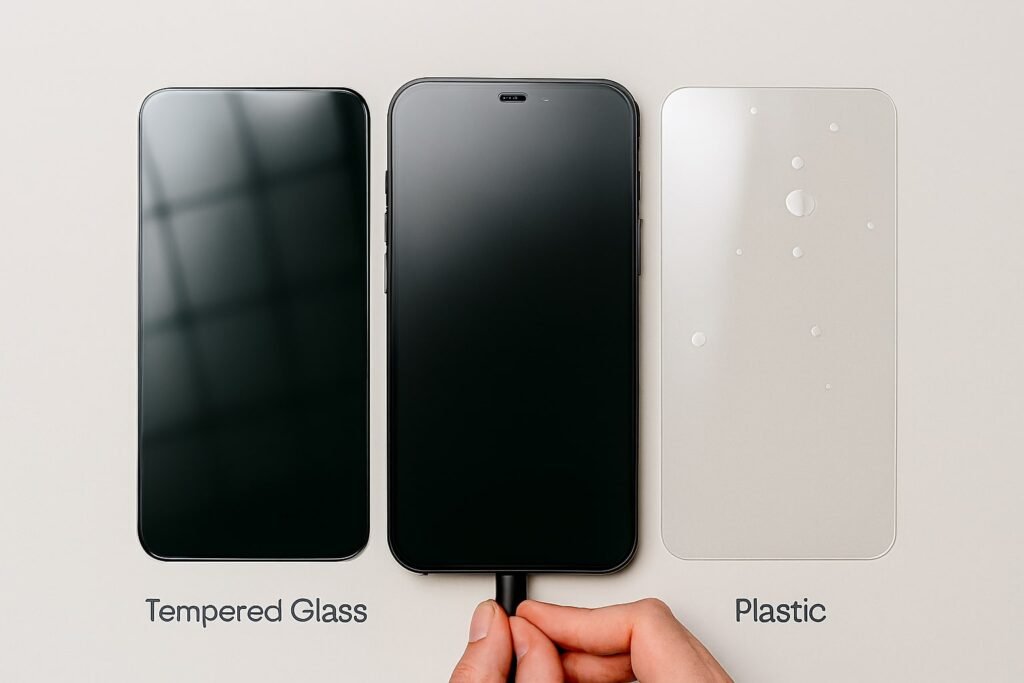Protecting your smartphone screen is important. You can choose between two types of screen protectors: tempered glass and plastic. Both protect your screen from scratches, smudges, and small bumps. But they are different in how long they last, how they feel, how much they cost, and how easy they are to put on.
Quick Comparison: Tempered Glass vs. Plastic Screen Protector
| Feature | Tempered Glass Screen Protector | Plastic Screen Protector |
|---|---|---|
| Durability | High | Moderate |
| Scratch Resistance | Excellent | Good |
| Touch Sensitivity | Excellent | Good |
| Clarity | Crystal Clear | Clear |
| Installation | Easy | Moderate |
| Price | Higher | Lower |
| Thickness | 0.3–0.5 mm | ~0.1 mm |
| Oleophobic Coating | Often Included | Rarely Included |
Understanding the Materials

Tempered Glass Screen Protectors
Tempered glass protectors are made from treated glass. This makes them stronger than normal glass. They resist scratches and impacts well. They are usually 0.3 to 0.5 mm thick, giving your phone good protection.
Benefits:
- Strong Protection: Resists scratches and impacts.
- Good Touch: Keeps your phone’s touch response accurate.
- Fingerprint Resistance: Many have a coating to reduce smudges.
Drawbacks:
- Higher Cost: More expensive than plastic.
- Chipping Risk: Edges can chip if dropped the wrong way.
- Thicker: May slightly affect button responsiveness or look.
Plastic Screen Protectors
Plastic protectors are made from PET or TPU. They are thin and flexible.
Benefits:
- Cheaper: Budget-friendly option.
- Flexible: Fits curved screens easily.
- Lightweight: Adds little bulk to your phone.
Drawbacks:
- Less Durable: Scratches easily and offers less impact protection.
- Touch Sensitivity: Can slightly reduce touch response.
- Clarity Issues: May turn cloudy or yellow over time.

Real-Life Use Cases
Scenario 1: Everyday User
If you use your phone for browsing, social media, or light gaming, a tempered glass protector is a good choice. It protects your screen from scratches and small impacts.
Scenario 2: Budget-Conscious Consumer
If you want protection without spending much, a plastic screen protector works well. It gives basic scratch protection, though not as strong as tempered glass.
Scenario 3: Outdoor Enthusiast
If you spend a lot of time outdoors and drop your phone sometimes, choose a tempered glass protector. It is strong and can handle rough conditions.
Pros and Cons
Tempered Glass Screen Protector
Pros:
- Strong protection from scratches and impacts.
- Keeps touch response accurate.
- Often has a coating to reduce fingerprints.
Cons:
- More expensive than plastic.
- Edges can chip if dropped.
- Thicker, may slightly affect the look of your phone.
Plastic Screen Protector
Pros:
- Cheap and budget-friendly.
- Flexible and light.
- Easy to fit on curved screens.
Cons:
- Less strong, scratches easily.
- Can reduce touch response slightly.
- May turn yellow or cloudy over time.
Comparison Table
| Feature | Tempered Glass Screen Protector | Plastic Screen Protector |
|---|---|---|
| Durability | High | Moderate |
| Scratch Resistance | Excellent | Good |
| Touch Sensitivity | Excellent | Good |
| Clarity | Crystal Clear | Clear |
| Installation | Easy | Moderate |
| Price | Higher | Lower |
| Thickness | 0.3–0.5 mm | ~0.1 mm |
| Oleophobic Coating | Often Included | Rarely Included |
Frequently Asked Questions
Q1: Which screen protector offers better protection?
A1: Tempered glass screen protectors provide superior protection against scratches and impacts due to their enhanced durability.
Q2: Are plastic screen protectors a good choice?
A2: Plastic screen protectors are a budget-friendly option that offers basic protection against scratches but may not withstand impacts as well as tempered glass.
Q3: Do tempered glass protectors affect touch sensitivity?
A3: No, tempered glass protectors maintain the original touch sensitivity of your device, providing a seamless user experience.
Q4: Can plastic screen protectors yellow over time?
A4: Yes, plastic screen protectors can discolor or yellow over time, affecting screen clarity.
Q5: Which screen protector is easier to install?
A5: Plastic screen protectors are generally easier to install, especially on curved screens, due to their flexibility.
Conclusion
Choosing a screen protector depends on your needs and budget. If you want strong protection, go with tempered glass. If you need a cheaper option for basic protection, plastic works. Think about how you use your phone to pick the best protector.
Author Bio:
John Doe is a technology enthusiast with over 10 years of experience in mobile accessories. He has extensively researched and tested various screen protectors to provide unbiased and informative reviews.


